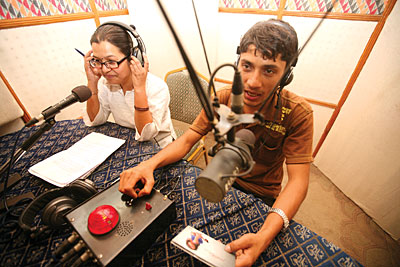 KIRAN PANDAY |
The mid-nineties witnessed an FM boom in Nepal, and today over 250 broadcasters are in business. In Pokhara alone, six FM stations compete for listeners. Being the oldest, Annapurna has built up a stable following among discerning listeners and upscale advertisers. Gandaki FM is a relative latecomer and has tried a different tack. It mainly caters to the taste of the working class and the rural audience. This could be why it is known as the media arm of the Maoists.
Gankadi FM came into being three years ago thanks to a group of small entrepreneurs.
Its marketers soon found out that despite their impressive audience size, advertisers did not take them seriously. So they decided to enter television broadcasting.
Gandaki Television operates out of a cramped studio, but the programs it offers more than make up for the lack of physical infrastructure. The news is shown in five local languages in addition to Nepali and English. Its executives claim that they have more viewers in Gandaki Zone than any national or international channel.
The group has now entered print media. Their logic is simple. They started with radio because of the ease of entry and low take-off costs. This established their presence and created audience loyalty. Television brought advertisers and revenue. Going into print is a means to obtain voice and respectability in the community. It may have something to do with the Brahminic culture of revering the printed page, but there is no denying that the editors of newspapers are accorded more respect than even hugely popular radio or television anchors.
Community radio began with a bang, but its influence is now on the wane. Most FM broadcasters lack the wherewithal to produce interesting programs, and are reduced to relaying Ujyaalo or Nepal FM material produced in Kathmandu.�Commentaries and features are taken from donor-funded and syndicated content providers like Communication Corner, Antenna Foundation or independent radio producers.
Financial assistance from donors did ensure the survival of FM radio initially, but it has damaged their credibility. Despite the gloss in sleekly produced pieces, the moment an INGO-sponsored program begins to play, listeners tune to stations broadcasting music. Audiences are not as gullible as communication strategists in Kathmandu think.
Overt political affiliations, too, have also dented the image of community radio. Unlike commercial media that have to maintain a non-partisan facade, local FM stations do not even bother to hide their political preferences. A tiny party like Rajendra Mahato's Sadbhavana faction has a string of FM stations in the central Tarai. Even in Kathmandu, where UML cadres staff most local radios, Radio Mirmire does not have to declare its politics, its listeners know it to be a Maoist mouthpiece.
Commercial FM radios too do not seem to be doing all that well. The 'national' claim of Kantipur FM is mostly notional: it is merely one of many choices on offer. With the airwaves jammed with channels, listeners have no brand loyalty.
The community radio revolution of Nepal has come full circle: FM stations have to compete for a share of the same advertising pie that sustains commercial broadcasting. The Gandaki FM group has responded with a media mix to thrive in the marketplace; others may have to create their own survival strategies for the cutthroat media wars to come.
READ ALSO:
Flex-ible, Prashant Jha
Engage the monarchy, Biraj Bahadur Bista
Politics abhors a vacuum, Publisher's Note
Ready, steady, no?, Dewan Rai
United we fall, Indu Nepal
Just questions, Ashutosh Tiwari
Two seconds to midnight, Ass
Whither constitution writing



